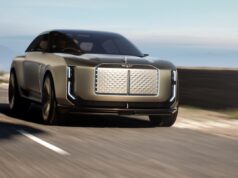
Yesterday a single image of the upcoming A4 was sedan was leaked onto the internet. Today Audi released more photos of the new sedan and the full details.
The new A4 sedan, which could be a 2008 model (we will find out next month) draws some inspiration from the new A5 coupe. The overall front end of the car looks very much like the A5 and may even have optional LED headlights. Luckily the one design element that the A4 sedan didn’t borrow from the A5 is the character line that runs on the side of the A5 (to some it looks a little odd).
Although the new design also looks similar to the current A4, there are large changes underneath the skin. The engine has been moved further back to improve weight distribution and to help the designers design a shorter front overhang. The interior of the new A4 is bigger due to a stretched wheelbase and overall the new car is larger than the current A4. At 185b inches long the new A4 is 4.5 nches longer than the previous version, seven inches longer than the 3-series and four inches longer than the C-Class.
Five different engines will be offered, with the smallest being a 1.8L TFSI with 160HP and the top gasoline powered engine will be the 265HP 3.2L FSI V6. Three diesel engines will be offered in Europe.
The new A4 is expected to be released in Europe by November and in the US sometime early next year.
Expect more details next month when the car is officially unveiled.
Full Story: Carscoop
Related Stories:
Official 2009 Audi A4 Photo Leaked…It Basically Looks Like a 4-Door A5
Audi’s Q7 V12 TDI SUV Will Debut Next Year
2010 Audi A7 Official Sketch Leaked…Are Four-Door Coupes the Next Big Thing?
2009 Audi Q5 Spy Photos…The Upcoming SUV is Nearly Undisguised
PRESS RELEASE:
The sportiest midsize saloon: The Audi A4
In its design, the new A4 reveals its sporty, progressive character: taut and dynamic in its outlines, it speaks the language of technical perfection. With an overall length of 4.70 metres, the saloon has a substantial, powerful road stance and offers its occupants ample space in an interior full of light. The workmanship is typical of an Audi – quality with no compromises. The controls can be backed by the extra refinement of innovative assistance and multimedia systems. In the safety area, the brand with the four-ring emblem sets new standards: the coordinated action of the airbags and front seat belt force limiters protects the occupants even more effectively.
When compared with the previous model, the A4 has new, sporty proportions. The front body overhang has been drastically shortened; the bonnet and wheelbase are both longer than before. In the driveline, the differential has changed places with the clutch (or torque converter), making it possible to move the front axle forward by 154 millimetres. This innovative solution ensures ideal axle-load distribution. The new A4 is the sportiest saloon in the midsize car category: agile, light and precise to control. Its dynamic suspension is a totally new design, with most of its components made from weight-saving aluminium.
The results are impressive: supremely dynamic road behaviour and effortlessly precise handling.
New high-tech options make the A4 driving experience even more fascinating: Audi drive select varies the engine, automatic transmission, steering and suspension damping characteristics to suit the driver’s preferences at any given moment. Audi dynamic steering varies its ratio according to the car’s speed and keeps the new A4 stable close to the handling limits by slight, almost instantaneous changes to the steering angle. The damping control system for the hydraulic shock absorbers varies the damping characteristic individually, to combine sporty driving enjoyment with maximum road safety.
The new Audi A4 is being introduced with a choice of five engines, their power outputs ranging from 105 kW (143 bhp) to 195 kW (265 bhp). The four-cylinder petrol engine, like the diesels, is turbocharged, and both types of engine have direct fuel injection. All the engines, with their supremely refined flow of power, make the A4 a pleasure to drive and, thanks to their high efficiency, consume distinctly less fuel than the previous versions.
Various transmissions are available: a six-speed manual gearbox, the tiptronic automatic transmission, the multitronic continuously variable transmission, and either front-wheel drive or quattro permanent all-wheel drive, which has been subjected to intensive development work that has made its performance even more dynamic.
Driveline
The new A4 is being launched with a choice of five powerful, refined engines. All of them, both petrol and diesel, use direct fuel injection, and the two four-cylinder units and the V6 TDI engines are turbocharged. With their splendid flow of power, these engines make driving the new A4 nothing less than pure pleasure. They also use less fuel than the equivalent engines in the previous model. Customers furthermore have a wide choice of high-tech transmissions: either a manual gearbox or automatic transmission can be specified. They transmit power to the front wheels or to a quattro permanent all-wheel driveline that has particularly dynamic settings.
Like the TDI diesels, the two petrol engines, the 3.2 FSI and the 1.8 TFSI, use the direct injection principle, in which fuel is delivered directly to the engine’s combustion chambers. When this fuel vaporises, it absorbs heat from the combustion chamber walls, which allows the engine to operate at a higher compression ratio. Its overall efficiency is thus higher – power and efficiency go together in every Audi.
The new 3.2 FSI, a member of Audi’s ultra-modern family of V engines, is the most powerful unit available in the new A4. From a displacement of 3197 cc, it develops 195 kW (265 bhp) and also delivers 330 Nm of torque all the way from 3000 to 5000 rpm. It accelerates the A4 3.2 FSI quattro with manual gearbox from a standstill to 100 km/h in only 6.2 seconds, and maintains this flow of power until the governed top speed of 250 km/h is reached. As an alternative from 2008 onwards, this engine can be combined with the 6-speed tiptronic automatic transmission; in either case, it delivers its power to the road via quattro permanent all-wheel drive.
The engine’s inlet valves are actuated by a pioneering innovation: the Audi valvelift system (AVS). It uses sliding sleeves (cam elements). These have different profiles, one alongside the other. They are slid along the camshafts in order to obtain smaller and larger amounts of valve lift.
The purpose of AVS is to ensure that the combustion chambers are always ideally filled; the throttle butterfly can then remain fully open in most cases, so that the engine breathes more efficiently.
The Audi A4 3.2 FSI with manual gearbox is content to consume an average of only 9.2 litres per 100 kilometres, 1.2 litres fewer than the previous car with a 188 kW (255 bhp) engine. About half of this improvement is due to the new valve actuating principle; the other half has been achieved by minimising internal friction. Oil pump volume is now smaller, with an optimised loss rating. Like the water pump, it now delivers a demand-controlled flow – another means of reducing fuel consumption.
The smaller of the two petrol engines, the compact four-cylinder 1.8 TFSI, is a highly efficient unit that develops 118 kW (160 bhp) and a torque of 250 Nm between 1500 and 4500 rpm from a displacement of 1798 cc. It accelerates the manual-gearbox A4 in 8.6 seconds to the typical main-road speed of 100 km/h, and maintains its thrust up to a top speed of 225 km/h. Yet according to the EU test cycle its consumption is only 7.1 l/100 km -1.1 litres per 100 kilometres better than the previous model. As an alternative to the manual gearbox, multitronic continuously variable transmission can be ordered, in both cases with front-wheel drive.
The 1.8 TFSI is a close relative of the 2.0 TFSI engine chosen three times in succession by a jury of international journalists as “Engine of the Year”. On this smaller version for use in the latest model line, direct petrol injection and turbocharging represent an ideal combination. Injection pressure has been increased to 150 bar, and new injectors distribute the fuel accurately to the combustion chambers. The turbocharger is exceptionally rapid in its response – at an engine speed of 2000 rpm it accelerates the engine 30 percent faster to a ten percent higher torque than the conventional 1.8T engine that powered the preceding model. For all its vigour, this four-cylinder unit runs quietly, in a most refined manner.
Supreme pulling power – the TDI engines
The three diesels for the new Audi A4 are two V6 units and a four-cylinder inline engine. Their strong performance makes them ideal representatives of a modern, powerful form of sporting character. Winning the Le Mans 24-hour race in 2006 and 2007 with the Audi R10 competition car was ample evidence of the power that can be summoned up by the TDI principle. Audi first introduced this efficient technology back in 1989, and it has remained the most efficient in the world to this very day. Since then, the brand with the four-ring emblem has not ceased to develop its technological lead.
The three-litre diesel is a new member of Audi’s V-engine family. It develops 176 kW (240 bhp) and has a peak torque of no less than 500 Nm all the way from 1500 to 3000 rpm. This large TDI unit, with its displacement of 2967 cc, makes the new A4 even more of a sports saloon. It needs only 6.1 seconds to accelerate to 100 km/h from a standing start, and has a top speed of 250 km/h, yet its average fuel consumption is a more than modest 6.9 l/100 km. The 3.0 TDI always has quattro permanent all-wheel drive.
The V6 TDI’s engine block is made from a light but rigid high-tech material: vermiculite graphite cast iron. Inside the engine, intensive fine tuning measures have minimised friction losses. The latest generation of common-rail fuel injection is used. Its high operating pressure atomises the fuel extremely finely, for a more uniform mixture and efficient combustion. The piezo injectors operate with immense speed and permit the fuel injection stroke to be divided up into individual stages, so that the engine runs exceptionally smoothly.
The exhaust-driven turbocharger is also a unit from the latest design generation. A high-speed actuating motor alters the position of its guide vanes, so that high torque builds up more rapidly and spontaneously. The 3.0 TDI already complies with forthcoming Euro 5 limits. A novel exhaust gas recirculation concept with increased cooling performance is used to reduce emissions of oxides of nitrogen.
The 2.7 TDI engine, with a displacement of 2698 cc, has been derived from the 3.0 TDI, and also complies already with the future Euro 5 exhaust emission limits. Its output is 140 kW (190 bhp) and it develops up to 400 Nm of torque between 1400 and 3250 rpm. As a result the A4 2.7 TDI sprints to 100 km/h from a standstill in 7.7 seconds and can reach a top speed of 226 km/h. Its average fuel consumption, on the other hand, is a modest 6.6 litres per 100 kilometres. The standard specification of this model includes multitronic continuously variable transmission and front-wheel drive – an ideal combination for relaxed, effortless driving.
Powerful and refined – the 2.0 TDI
The four-cylinder TDI engine, with a displacement of 1968 cc, is a new interpretation of the strengths of the TDI concept. The piezo injectors of its common-rail fuel injection system operate at a maximum pressure of 1800 bar. Other innovative design features relate to the turbocharger, the toothed belt camshaft drive and the geometry of the pistons.
This two-litre engine develops 105 kW (143 bhp) and has the powerful peak torque of 320 Nm between 1750 and 2500 rpm – figures that explain why the new Audi A4 can accelerate from 0 to 100 km/h in 9.4 seconds and reach a top speed of 215 km/h. When combined with the six-speed manual gearbox, the 2.0 TDI is content with an average fuel consumption of 5.5 l/100 km, in which case the 65-litre fuel tank provides an action radius of more than 1,100 kilometres. The four-cylinder TDI can also be ordered with the multitronic continuously variable transmission. In both cases the front wheels are driven.
The 2.0 TDI also outperforms the Euro 5 exhaust emission limits. Thanks to improved thermodynamics, it can operate at a higher rate of exhaust gas recirculation, so that untreated emissions of oxides of nitrogen are lower. The cooler combustion process, with less oxygen present, would normally have an adverse effect on efficiency, but by careful attention to detail the development engineers have managed to transform this into an improvement in fuel consumption.
Transmissions: a wide choice
Sporty road dynamics and large-car comfort – these were also the overall objectives for the new A4 pursued by Audi’s transmission developers. The manual gearbox is a new design; the tiptronic six-speed automatic and multitronic continuously variable transmissions have been intensively revised and improved. All these transmissions are notable for their ease of operation and high efficiency, with short, precise lever or selector travel. The transmission layout has been changed for the new A4: the differential is located immediately behind the engine and is therefore now ahead of the clutch or torque converter.
Audi uses two types of six-speed manual gearbox on the new model, depending on the required load capacity. Numerous measures have been taken to reduce internal friction. All manual-gearbox versions of the new A4 have a gear indicator integrated into the Driver Information System display. It shows which gear is currently selected and also informs the driver if a different gear would help to reduce fuel consumption.
The new A4 3.2 FSI will be available later with 6-speed tiptronic automatic transmission as an alternative to the manual gearbox. The tiptronic transmission has been extensively revised. It responds more rapidly than on the previous model, with shorter shift times, but its high standard of refinement has nonetheless been retained.
For the 2.7 TDI, Audi can supply the multitronic continuously variable transmission; this will also be available in the 1.8 TFSI and 2.0 TDI from 2008 onwards. Its power losses, already very slight, have been reduced still further by a number of improvements. The new variator provides wider-spaced ratios. Thanks to a particularly low drive-off ratio, the A4 with multitronic sprints away vigorously from a standstill. When accelerating in the dynamic Sport programme, eight successive ratios are selected by way of fixed, programmed characteristics, for sporty performance. In the manual selection mode, the driver can select these eight ratios as he or she prefers.
Audi has a sporty trendsetter in its portfolio: quattro permanent all-wheel drive. The additional traction, dynamism, driving safety and directional stability it provides are clues to Audi’s proverbial technological lead, as summed up in its slogan ‘Vorsprung durch Technik’. For the new A4, this driveline has a 40:60 torque split and therefore distributes power to the wheels in a sportier, more fascinating way than ever before. The 3.2 FSI and 3.0 TDI have the quattro driveline as standard equipment.
The key element in the quattro driveline for the new Audi A4 is a self-locking centre differential. It has an entirely mechanical action and reacts instantly to changes in the driving situation, thus contributing to the car’s sporty, agile road dynamics. In normal driving conditions, it directs 40 percent of engine torque to the front wheels and 60 percent to the rear, but whenever the need arises, the self-locking centre differential takes effect and transmits more torque to the axle with better traction. In this way the new Audi A4 often masters situations close to the traction limit without the ESP/EDL having to intervene, and even if these systems are in action, brake applications are much less frequent.
Equipment and trim, data and prices stated here refer to the model programme offered for sale in Germany. Subject to amendment; errors and omissions excepted.















